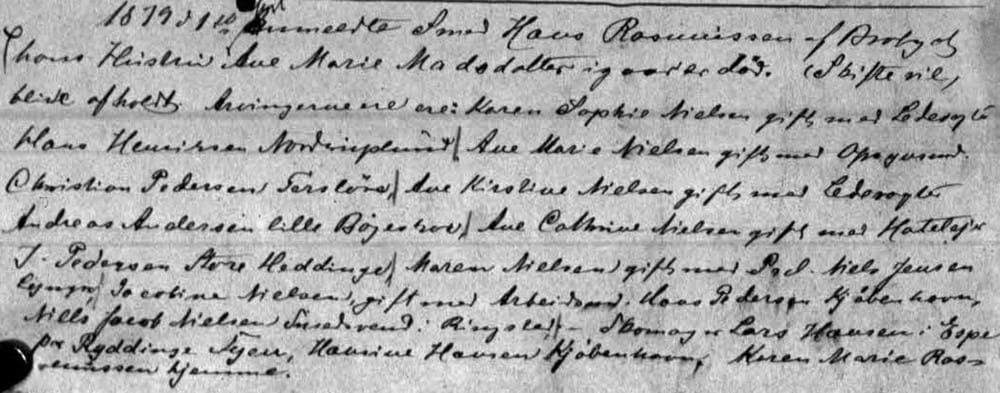Most Danes did not and still don't write a will. Furthermore, all deaths had to be reported to the probate court. Therefore, you should always start by looking at probate records when you want to document a deceased person's heirs and property. The court records reveal how the estate was handled, and if there was will. If the court was involved in the division of the estate, more than one court record was usually made, as explained in my previous blog post Types of Danish Probate Records.
Record of the Death Report
The death report record says that on 1 April 1879, Hans Andersen reported that his wife Ane Marie Madsdatter had died, and that the heirs were as follows:
- Karen Sophie Nielsen, married to Hans Henriksen [in] Nordruplund.
- Ane Marie Nielsen, married to Christian Pedersen [in] Tersløse.
- Ane Kirstine Nielsen, married to Andreas Andersen [in] Lille Bøgeskov.
- Ane Cathrine Nielsen, married to J. Pedersen [in] Store Heddinge.
- Maren Nielsen, married to Niels Jensen [in] Lynge.
- Jacobine Nielsen, married to Hans Pedersen [in] Copenhagen.
- Niels Jacob Nielsen in Ringsted.
- Lars Hansen in Espe by Ryddinge [at] Funen.
- Hansine Hansen [in] Copenhagen.
- Karen Marie Rasmussen, at home.1
The record does not specify the relationship between Ane Marie Madsdatter and her heirs.
Minutes from a Gathering of Heirs
The second record contains court minutes form a gathering of the heirs. It reveals that the widower Hans Rasmussen had not been able to reach an agreement about the division "with his stepchildren." Therefore, he wanted the court to lead the proceedings.
Niels Andersen in Broby was present on behalf of the heir Karen Marie Rasmussen, and he presented a will written by the deceased, dated 3 March "this year." Except for Hansine Hansen and Hans Pedersen [on behalf of his wife Jacobine Nielsen], all the other heirs were present in the court. They stated that the first seven children were by the deceased's marriage to Niels Jacobsen, the next two were by her marriage to Hans Nielsen, and the last one by the widower.
The total assets of the estate were valued at 7946 kroner. Most of it came from the inherited copyhold at lot numbers 20 and 21 in Broby, which was valued at 6000 kr. The debt of the estate was 1628 kroner.
The heirs contested the value of the copyhold; however, the meeting ended with the agreement that each child should receive 250 kroner as inheritance. The rest belonged to the widower. [And in turn to his daughter Karen Marie Rasmussen.]
The widower had to pay the costs of the court proceedings, and each heir had to pay taxes of their own inheritance.2
What about the Will?
A notarial record tells us that Ane Marie Madsdatter signed her will in the presence of the representative for the notary for Sorø and two witnesses on 3 March 1879. The will was read out loud to her and she stated that it was her will. She could not write, so – as was custom in Denmark – someone held the pen with her and helped her write her name. The notary's representative and the witnesses signed both the will and the notarial record.3 The notarial record does not reveal the contents of the will.
The will was held privately, and its contents were probably not recorded in any public record. Therefore, the information in the court records is likely the only available information about the division of Ane Marie Madsdatter's estate.
Female Heirs
The image at the top of the post shows the signatures below the court minutes. Thirteen people signed the record. Ane Marie Madsdatter left behind eight daughters, but they did not sign the record. Men signed on their behalf. Women did not negotiate or sign agreements themselves. That practice has its pros and cons. I like to focus on one of the pros: If a female heir was married, the court record provides her husband's name, occupation, and residence, which is a great help when trying to identify descendants.
Source References
- Sorø By og Birk, Dødsanmeldelsesprotokol [book of death reports] 1876-1879, unpaginated, 1 April 1879, report by Hans Rasmussen about Ane Marie Madsdatter; image copy, The Danish National Archives, Arkivalieronline (https://www.sa.dk/ao-soegesider/da/billedviser?epid=17021129#128623,33602770).
- Sorø By og Birk, Skifteprotokol for Sorø Birk i Sorø Amt [book of probates for Sorø Birch in Sorø County] 1876-1881, folio 221 recto to verso, 10 May 1879, the estate after Ane Marie Madsdatter; image copy, The Danish National Archives, Arkivalieronline (https://www.sa.dk/ao-soegesider/da/billedviser?epid=14938124#129523,33744317).
- Sorø By og Birk, Notarialprotokol [notarial record book] 1867-1886, folio 136 verso, 3 March 1879, attestation of Ane Marie Madsdatter's will; image copy, The Danish National Archives, Arkivalieronline (https://www.sa.dk/ao-soegesider/da/billedviser?epid=21913269#430067,78615632).







